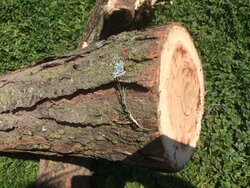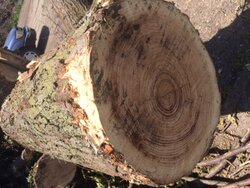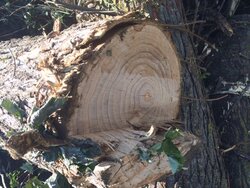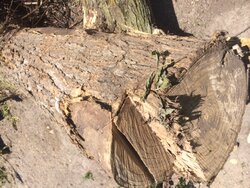Do you have a chainsaw? If so, you can cut the wood into rounds of the proper length, and who knows, you
may be able to split it with a 6# maul (my go-to splitting tool, although I also have a power splitter.) Heck, I'll split a lot of the easy-splitting stuff with a maul, and I'm an old man!

If you plan on burning wood this winter, time is short to get it dry enough unless you can score some quick-drying woods like soft Maple, Tulip Poplar, Pine, Cherry, etc. You must have dry wood for good results from a modern stove (post-1990) which re-burns the smoke. The wood has to be split small and stacked in the wind to dry as fast as possible. Or you may be able to find a firewood seller who has split wood left over from last season; That might get fairly dry by this winter except for Oak, which may be the
slowest-drying wood. You can always mix some compressed-wood product logs (not Dura-flame or the like) in with your semi-dry wood to get an acceptable result.
So what stove make and model did you inherit? If you know, you can add it to your signature, then people can offer burning advice based on your type of stove.








 I agree with P.A., first looks like Honey.
I agree with P.A., first looks like Honey.
 If you can cut a representative big-diameter round off each of the different logs, then split a few, maybe you can get us some more pics of end grain, bark, and split face. Lots of good ID folks here that should be able to nail 'em down.
If you can cut a representative big-diameter round off each of the different logs, then split a few, maybe you can get us some more pics of end grain, bark, and split face. Lots of good ID folks here that should be able to nail 'em down. If you plan on burning wood this winter, time is short to get it dry enough unless you can score some quick-drying woods like soft Maple, Tulip Poplar, Pine, Cherry, etc. You must have dry wood for good results from a modern stove (post-1990) which re-burns the smoke. The wood has to be split small and stacked in the wind to dry as fast as possible. Or you may be able to find a firewood seller who has split wood left over from last season; That might get fairly dry by this winter except for Oak, which may be the slowest-drying wood. You can always mix some compressed-wood product logs (not Dura-flame or the like) in with your semi-dry wood to get an acceptable result.
If you plan on burning wood this winter, time is short to get it dry enough unless you can score some quick-drying woods like soft Maple, Tulip Poplar, Pine, Cherry, etc. You must have dry wood for good results from a modern stove (post-1990) which re-burns the smoke. The wood has to be split small and stacked in the wind to dry as fast as possible. Or you may be able to find a firewood seller who has split wood left over from last season; That might get fairly dry by this winter except for Oak, which may be the slowest-drying wood. You can always mix some compressed-wood product logs (not Dura-flame or the like) in with your semi-dry wood to get an acceptable result.